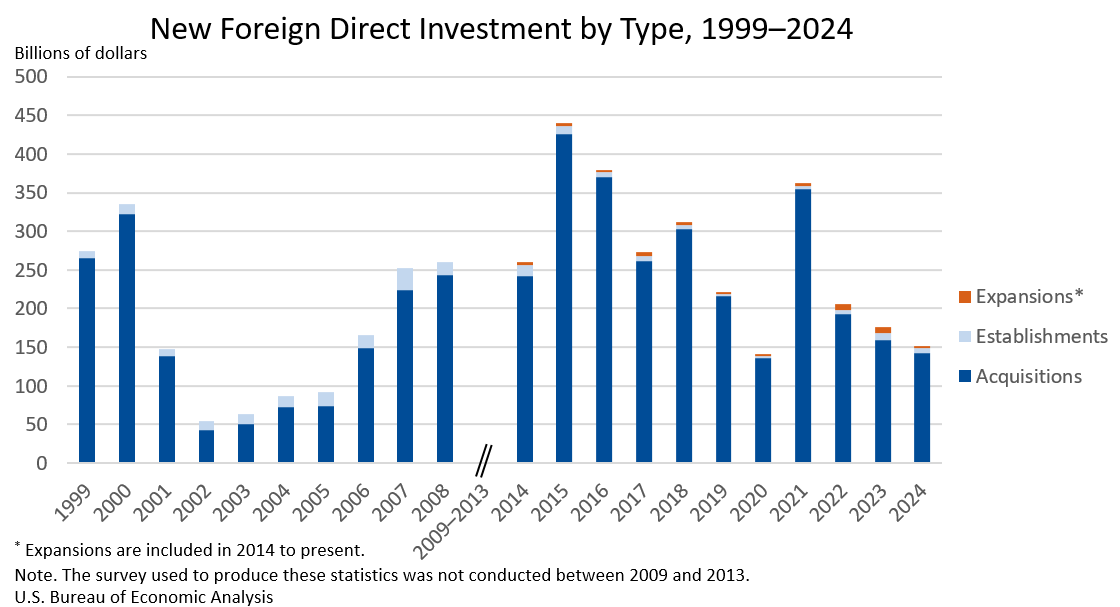Bureau of Economic Analysis
New Foreign Direct Investment in the United States, 2024
Expenditures by foreign direct investors to acquire, establish, or expand U.S. businesses totaled $151.0 billion in 2024, according to preliminary statistics released today by the U.S. Bureau of Economic Analysis. Expenditures decreased $24.9 billion, or 14.2 percent, from $176.0 billion (revised) in 2023 and were below the annual average of $277.2 billion for 2014–2023. As in previous years, acquisitions of existing U.S. businesses accounted for most of the expenditures.
Principal Federal Economic Indicators
Noteworthy
- 2025 News Release Schedule
- Innovation at BEA
- 2025 Annual Updates
- New! Services Trade Data for More Countries
- Data Tool: Trade in Value Added
- Distribution of State Personal Income
- Updated: RIMS II Regional Multipliers
- Arts and Culture
- Space Economy
- FDI Now in State BEARFACTS
- Quick Guide: Price Indexes
The Latest
Gross Domestic Product by State and Personal Income by State, Year 2022
Real gross domestic product (GDP) increased in 42 states and the District of Columbia in 2022, with the percent change in real GDP ranging from 4.9 percent in Idaho to –2.4 percent in Alaska.
Gross Domestic Product by State and Personal Income by State, 4th Quarter 2022
Real gross domestic product (GDP) increased in 46 states and the District of Columbia in the fourth quarter of 2022, with the percent change in real GDP ranging from 7.0 percent in Texas to –4.3 percent in South Dakota.
Gross Domestic Product by State and Personal Income by State, 4th Quarter 2022 and Year 2022
Real gross domestic product (GDP) increased in 46 states and the District of Columbia in the fourth quarter of 2022, with the percent change in real GDP ranging from 7.0 percent in Texas to –4.3 percent in South Dakota. Personal income increased in 48 states and the District of Columbia in the fourth quarter, with the percent change ranging from 15.3 percent in Massachusetts to –2.5 percent in Colorado.
Personal Income and Outlays, February 2023
Personal income increased $72.9 billion, or 0.3 percent at a monthly rate, while consumer spending increased $27.9 billion, or 0.2 percent, in February. The increase in personal income primarily reflected an increase in compensation. The personal saving rate (that is, personal saving as a percentage of disposable personal income) was 4.6 percent in February, compared with 4.4 percent in January.
Personal Income and Outlays, February 2023
Personal income increased $72.9 billion, or 0.3 percent at a monthly rate, while consumer spending increased $27.9 billion, or 0.2 percent, in February. The increase in personal income primarily reflected an increase in compensation. The personal saving rate (that is, personal saving as a percentage of disposable personal income) was 4.6 percent in February, compared with 4.4 percent in January.
Gross Domestic Product, Fourth Quarter and Year 2022 (Third Estimate), GDP by Industry, and Corporate Profits
Real gross domestic product (GDP) increased at an annual rate of 2.6 percent in the fourth quarter of 2022, after increasing 3.2 percent in the third quarter. The increase in the fourth quarter primarily reflected increases in inventory investment and consumer spending that were partly offset by a decrease in housing investment. Profits decreased 2.0 percent in the fourth quarter after decreasing less than 0.1 percent in the third quarter…
Gross Domestic Product (Third Estimate), Corporate Profits, and GDP by Industry, Fourth Quarter and Year 2022
Real gross domestic product (GDP) increased at an annual rate of 2.6 percent in the fourth quarter of 2022, after increasing 3.2 percent in the third quarter. The increase in the fourth quarter primarily reflected increases in inventory investment and consumer spending that were partly offset by a decrease in housing investment.
U.S. International Investment Position, Year 2022
The U.S. net international investment position, the difference between U.S. residents’ foreign financial assets and liabilities, was –$16.12 trillion at the end of 2022, according to statistics released today by the U.S. Bureau of Economic Analysis (BEA). Assets totaled $31.68 trillion, and liabilities were $47.80 trillion. At the end of 2021, the net investment position was –$18.12 trillion.
U.S. International Investment Position, 4th Quarter and Year 2022
The U.S. net international investment position, the difference between U.S. residents' foreign financial assets and liabilities, was -$16.12 trillion at the end of the fourth quarter of 2022, according to statistics released today by the U.S. Bureau of Economic Analysis. Assets totaled $31.68 trillion, and liabilities were $47.80 trillion. At the end of the third quarter, the net investment position was -$16.84 trillion (revised).
U.S. International Investment Position, 4th Quarter 2022
The U.S. net international investment position, the difference between U.S. residents’ foreign financial assets and liabilities, was –$16.12 trillion at the end of the fourth quarter of 2022, according to statistics released today by the U.S. Bureau of Economic Analysis (BEA). Assets totaled $31.68 trillion, and liabilities were $47.80 trillion. At the end of the third quarter, the net investment position was –$16.84 trillion (revised).




